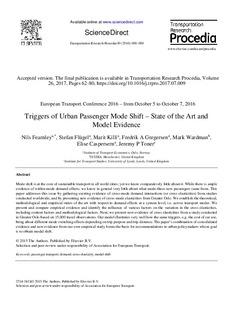| dc.contributor.author | Fearnley, Nils | |
| dc.contributor.author | Flugel, Stefan Markus | |
| dc.contributor.author | Killi, Marit | |
| dc.contributor.author | Gregersen, Fredrik Alexander | |
| dc.contributor.author | Wardman, Mark | |
| dc.contributor.author | Caspersen, Elise | |
| dc.contributor.author | Toner, Jeremy P | |
| dc.coverage.spatial | Norway | nb_NO |
| dc.date.accessioned | 2019-06-27T10:24:16Z | |
| dc.date.available | 2019-06-27T10:24:16Z | |
| dc.date.created | 2017-09-19T14:50:53Z | |
| dc.date.issued | 2017-08-14 | |
| dc.identifier.citation | Transportation Research Procedia. 2017, 26 62-80. | nb_NO |
| dc.identifier.issn | 2352-1465 | |
| dc.identifier.uri | http://hdl.handle.net/11250/2602523 | |
| dc.description.abstract | Mode shift is at the core of sustainable transport in all world cities; yet we know comparatively little about it. While there is ample evidence of within-mode demand effects, we know in general very little about what mode these new passengers came from. This paper addresses this issue by gathering existing evidence of cross-mode demand interactions (or cross elasticities) from studies conducted worldwide, and by presenting new evidence of cross-mode elasticities from Greater Oslo. We establish the theoretical, methodological and empirical states of the art with respect to demand effects at a system level, i.e. across transport modes. We present and compare empirical evidence and identify the influence of various factors on the variation in the cross elasticities, including context factors and methodological factors. Next, we present new evidence of cross elasticities from a study conducted in Greater Oslo based on 15,000 travel observations. Our model illustrates very well how the same triggers, e.g. the cost of car use, bring about different mode switching effects depending on trip purpose and trip distance. The paper's combination of consolidated evidence and new evidence from our own empirical study forms the basis for recommendations to urban policymakers whose goal is to obtain modal shift. | nb_NO |
| dc.description.abstract | Triggers of Urban Passenger Mode Shift – State of the Art and Model Evidence | nb_NO |
| dc.language.iso | eng | nb_NO |
| dc.publisher | Elsevier | nb_NO |
| dc.relation.uri | http://www.sciencedirect.com/science/article/pii/S2352146517308682 | |
| dc.rights | Attribution-NonCommercial-NoDerivatives 4.0 Internasjonal | * |
| dc.rights.uri | http://creativecommons.org/licenses/by-nc-nd/4.0/deed.no | * |
| dc.title | Triggers of Urban Passenger Mode Shift – State of the Art and Model Evidence | nb_NO |
| dc.title.alternative | Triggers of Urban Passenger Mode Shift – State of the Art and Model Evidence | nb_NO |
| dc.type | Journal article | nb_NO |
| dc.type | Peer reviewed | nb_NO |
| dc.rights.holder | © 2017 The Authors. Published by Elsevier B.V. | nb_NO |
| dc.description.version | publishedVersion | nb_NO |
| cristin.unitcode | 7482,1,5,0 | |
| cristin.unitcode | 7482,3,2,0 | |
| cristin.unitcode | 7482,3,1,0 | |
| cristin.unitcode | 7482,1,1,0 | |
| cristin.unitcode | 7482,3,4,0 | |
| cristin.unitname | Marked og styring | |
| cristin.unitname | Transportmodeller | |
| cristin.unitname | Samfunnsøkonomiske analyser | |
| cristin.unitname | Reisevaner og mobilitet | |
| cristin.unitname | Logisikk og innovasjon | |
| cristin.ispublished | true | |
| cristin.fulltext | original | |
| cristin.qualitycode | 1 | |
| dc.identifier.doi | 10.1016/j.trpro.2017.07.009 | |
| dc.identifier.cristin | 1495462 | |
| dc.source.journal | Transportation Research Procedia | nb_NO |
| dc.source.volume | 26 | nb_NO |
| dc.source.pagenumber | 62-80 | nb_NO |
| dc.relation.project | Norges forskningsråd: 246836 | nb_NO |

